#Ceratioidei
Explore tagged Tumblr posts
Text
Fact Of The Day, October 6, 2024:
The males of Ceratioidei, one of the four anglerfish suborders, are many times smaller than the females and only survive by physically attaching to one of them for their entire lives.
2 notes
·
View notes
Note
🙃🍪 please!
🙃 What’s a weird fact that you know?
You get one that I just learned last night!
So the popular image of the anglerfish, is of one swimming like a normal fish, with the little lure dangling out in front like a fishing pole, right?
Well, according to a new paper, a lot of anglerfish in the genus Gigantactis apparently don't swim like that! They swim upside down!
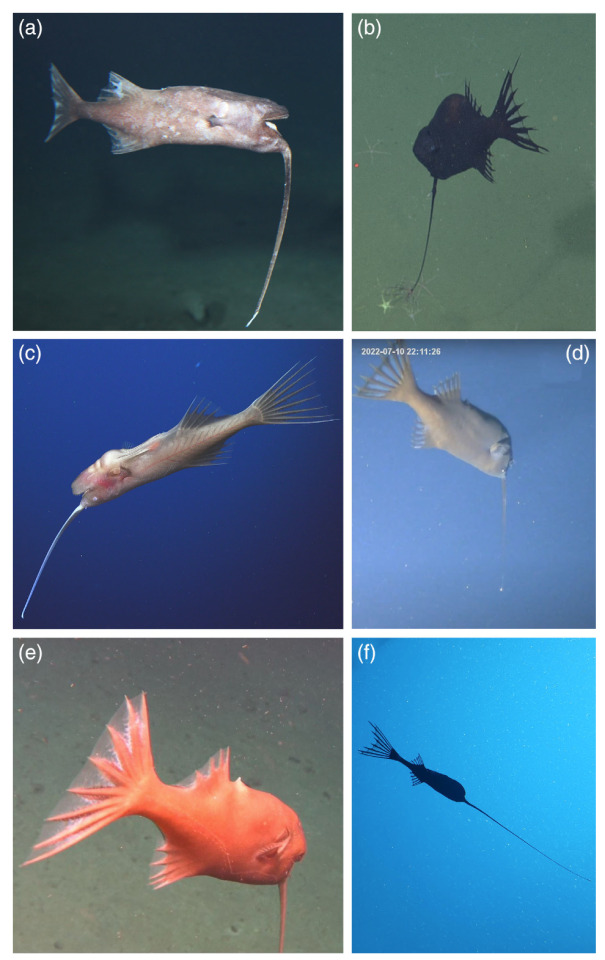
All of these fish are alive, and the paper notes that several were approached by the ROV, which disturbed the fish. The fish then swam away, still upside-down. The thought, so roughly stated, is that maybe these fish are targeting prey relatively near the bottom, so the upside-down swimming is to better get the lure near the target prey species.
Citation below, paper's linked above; if someone wants a copy, I've got institutional access. ^^
Stewart, A. L., Pietsch, T. W., Moore, J., & Peng, X. (2023). Upside-down swimming: in situ observations of inverted orientation in Gigantactis, with a new depth record for the Ceratioidei. Journal of Fish Biology, 1–5. https://doi.org/10.1111/jfb.15609
🍪 If you were a cookie, what kind would you be?
The one messily devoured. XD
Um, more seriously... Probably a black-and-white cookie, or a half-moon cookie? I just like them.
(I know there's technically a difference in the two cookies regarding the cake base and sometimes the frosting choice, but I grew up in a cookie hybrid zone where elements of both the black-and-white and the half-moon are present, so I've used the terms relatively loosely in my life. Whatever name you ascribe to a cookie with a specifically-dense chocolate or lemon base, topped with one part smooth chocolate fondant, and either fluffy or fondant vanilla icing, that's the cookie I mean.)
#phoenix sounds#I love anglerfish so very very much#And I know the cookie I describe is not quite either one but hey#It's the cookie I grew up with
3 notes
·
View notes
Text
Tag 9 people you want to know better
Thanks for tagging me, @laguzmage!
Last song I listened to: I'm actually gonna post a few things here since I've been cycling through a lot of stuff, but the literal response is this:
youtube
Every once in a while there's an artist that I see around a bunch but never actually think to connect everything I saw from them until I look them up for unrelated reasons, and Aiobahn is one of them. Specifically, I've seen bits of their animations used in memes for a while but only recently looked up the artist properly by chance.
Next up:
youtube
It's just... really easy to listen to. I often have it on in the background when I'm on break at work, just to have some background music and to block out noise.
and just to prove I don't only listen to weeb music or video game music, here's the last one
youtube
I say Poets of the Fall is not video game music, but some of their singles are actually featured in a couple games! They often get used in Remedy's games, notably The Late Goodbye in Max Payne 2, War in Alan Wake, and My Dark Disquiet in Control. They also do a few tracks specifically for Alan Wake and Control under the name of the in-universe group "Old Gods of Asgard". That said aside from the last bit their tracks are definitely not video game music, and even the ones that show up in games are more akin to pop songs getting put in movies than video game music, in my opinion. I first heard them when I played Alan Wake for the first time, and have been a fan of the group for more than ten years now.
Currently watching: I'm actually awful at watching things, unless I happen to be playing or doing something that takes little enough mental effort I can focus on it, like gathering in FF XIV or playing Elite Dangerous. I've been meaning to watch Bocchi the Rock and finish Witch from Mercury but I just haven't gotten around to it yet.
Currently reading: I've been re-reading the 2nd Omnibus for Otherside Picnic, which covers volumes 3-4 of the light novels. There's some fun drama in the first half and really good scenes in the second half, so it's a fun time. I've been wanting to read more books, some friends have recommended Gideon the Ninth, the Wheel of Time series, and Kings of the Wyld so I'd like to give them a shot one day, and I've seen stuff about the Black Company series that makes it sound really interesting, so it's also on The List
Current obsession: I've been going crazy on Baldur's Gate and also recently got into Warhammer 40k, so those have been eating up my life. Running a paladin in Baldur's Gate is super fun, and when I need a break I swap over to painting my Sisters of Battle. Behold, the first mini I've ever painted, a Sacresanct Superior!

That's it for me though. I genuinely don't know if I have 9 people to tag, but I'd like to hit @ceratioidei and if any mutuals want to do this and treat it as if I tagged them hopefully that works lmao.
2 notes
·
View notes
Note
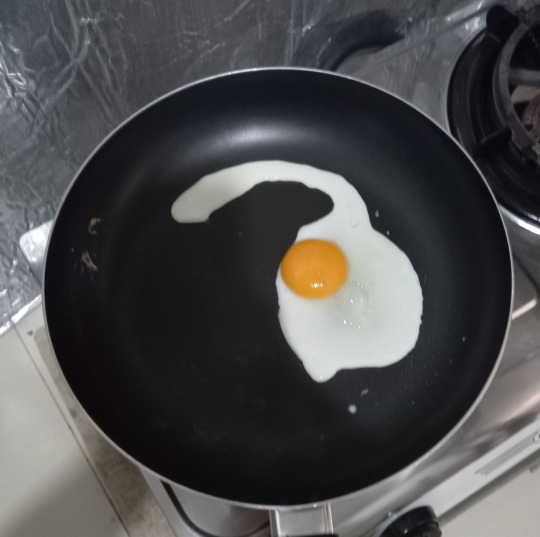
angler fish
The anglerfish are fish of the teleost order Lophiiformes (/ˌlɒfiɪˈfɔːrmiːz/).[1] They are bony fish named for their characteristic mode of predation, in which a modified luminescent fin ray (the esca or illicium) acts as a lure for other fish. The luminescence comes from symbiotic bacteria, which are thought to be acquired from seawater,[2][3] that dwell in and around the sea.
Some anglerfish are notable for extreme sexual dimorphism and sexual symbiosis of the small male with the much larger female, seen in the suborder Ceratioidei, the deep sea anglerfish. In these species, males may be several orders of magnitude smaller than females.[4]
Anglerfish occur worldwide. Some are pelagic (dwelling away from the sea floor), while others are benthic (dwelling close to the sea floor). Some live in the deep sea (such as the Ceratiidae), while others live on the continental shelf, such as the frogfishes and the Lophiidae (monkfish or goosefish). Pelagic forms are most often laterally compressed, whereas the benthic forms are often extremely dorsoventrally compressed (depressed), often with large upward-pointing mouths.[citation needed]
Evolution[edit]
The earliest fossils of anglerfish are from the Eocene Monte Bolca formation of Italy, and these already show significant diversification into the modern families that make up the order.[5] Given this, and their close relationship to the Tetraodontiformes, which are known from Cretaceous fossils, they likely originated during the Cretaceous.[6][7] A 2010 mitochondrial genome phylogenetic study suggested the anglerfishes diversified in a short period of the early to mid-Cretaceous, between 130 and 100 million years ago.[8] A more recent preprint reduces this time to the Late Cretaceous, between 92 to 61 million years ago.[7] Other studies indicate that anglerfish only originated shortly after the Cretaceous-Paleogene extinction event as part of a massive adaptive radiation of percomorphs, although this clashes with the extensive diversity already known from the group by the Eocene.[7][9]
Classification[edit]
FishBase,[1] Nelson,[10] and Pietsch[11] list 18 families, but ITIS[12] lists only 16. The following taxa have been arranged to show their evolutionary relationships.[4]
Suborder Lophoiodei
Lophiidae (goosefishes or monkfishes)
Suborder Antennarioidei
Antennariidae (frogfishes)
Tetrabrachiidae (four-armed frogfishes)[13]
Brachionichthyidae (handfishes)
Lophichthyidae (Boschma's frogfish)[13]
Suborder Chaunacoidei
Chaunacidae (sea toads)
Suborder Ogcocephaloidei
Ogcocephalidae (batfishes)
Suborder Ceratioidei
Centrophrynidae (prickly seadevils)
Ceratiidae (warty seadevils)
Himantolophidae (footballfishes)
Diceratiidae (doublespine seadevils)
Melanocetidae (black seadevils)
Thaumatichthyidae (wolf-trap seadevils)
Oneirodidae (dreamers)
Caulophrynidae (fanfin seadevils)
Neoceratiidae (needlebeard seadevil)
Gigantactinidae (whipnose seadevils)
Linophrynidae (leftvent seadevils)
Red-lipped batfishStriped anglerfish (Antennarius striatus
1 note
·
View note
Text
it does indeed! the short answer is that the anglerfishes (Lophiiformes: Ceratioidei) who practice sexual parasitism (only maybe two dozen out of over 170 species)[1] mostly don’t have adaptive immune systems anymore, jettisoning anywhere from half to all of the major histocompatibility complex genes and a lot of the code for T and B cell proteins.[2] while it’s not unheard of for modern bony fishes to drop the MHC class II genes for various reasons (pipefish[3], cod[4], a single monkfish[5]), the general trend is for them to have a far more diverse set of MHC class I genes than mammals do[6]. except in the deep sea, where exists a lanternfish (Benthosema glaciale) sans its mhc1u lineage[4] and the ceratioid anglerfishes.
anglerfishes who practice sexual parasitism have a significant contraction of the MHC class I genes and are missing the proteins that let T cells interact with MHC class I molecules, and species that form consortial matings (2+ males, the record is the Queen of the Deep's eight, yeah this is a huge fucking deal from a histocompatibility perspective) also kick the class II genes as well as both rag1 and rag2 (genes whose absence causes the lethal state of severe combined immunodeficiency in mammals).[2] going hypothesis is that they might have hardwired some of the adaptive upregulation of the innate immune system known to occur in rag1-deficient zebrafish[7], which might explain how they don’t drop like flies from all the microorganisms in the abyssal zone[8] but is not a fully satisfactory explanation for the lack of allograft rejection response, given the differences in which pathways get dropped. Ceratias, a monogamous genus, dropped the mhc1u lineage but significantly expanded the mhc1z lineage,[2] so, like... what gives there? (yeah it does fucking kill my friends who actually work in this field that both in situ and in vivo study of this group are currently impossible, on account of the “lives six miles underwater” thing.)
separately, there’s a good chance immune response changes first and sexual parasitism follows afterwards: all the ceratioids have the famous exaggerated sexual dimorphism and all of them perform some form of attachment, but in most of them the male just bites down and hitches a ride for a bit, then lets go and moves on. given the relative lack of nutrients in the deep sea, the evolutionary trend may be for anglerfishes to drop immune infrastructure for metabolic cost reasons and for full-fusion sexual parasitism to arise to take advantage of it, which would explain why 1) sexual parasitism has evolved 3-5 separate times in this suborder[1], and 2) why Vanhöffen’s whipnose, which does not practice sexual parasitism, also doesn’t have a fucking adaptive immune system.[2]
1. Pietsch, T. W. Dimorphism, parasitism, and sex revisited: modes of reproduction among deep-sea ceratioid anglerfishes (Teleostei: Lophiiformes). Ichthyol Res 52, 207–236 (2005).
2. Swann, J. B., Holland, S. J., Petersen, M., Pietsch, T. W. & Boehm, T. The immunogenetics of sexual parasitism. Science 369, 1608–1615 (2020).
3. Haase, D. et al. Absence of major histocompatibility complex class II mediated immunity in pipefish, Syngnathus typhle: evidence from deep transcriptome sequencing. Biology Letters 9, 20130044 (2013).
4. Malmstrøm, M. et al. Evolution of the immune system influences speciation rates in teleost fishes. Nat Genet 48, 1204–1210 (2016).
5. Dubin, A., Jørgensen, T. E., Moum, T., Johansen, S. D. & Jakt, L. M. Complete loss of the MHC II pathway in an anglerfish, Lophius piscatorius. Biology Letters 15, 20190594 (2019).
6. Yamaguchi, T. & Dijkstra, J. M. Major Histocompatibility Complex (MHC) Genes and Disease Resistance in Fish. Cells 8, 378 (2019).
7. Tokunaga, Y. et al. Comprehensive validation of T- and B-cell deficiency in rag1-null zebrafish: Implication for the robust innate defense mechanisms of teleosts. Sci Rep 7, 7536 (2017).
8. Freeman, M. A. et al. Spraguea (Microsporida: Spraguidae) infections in the nervous system of the Japanese anglerfish, Lophius litulon (Jordan), with comments on transmission routes and host pathology. J Fish Dis 34, 445–452 (2011).
did you know that the well-known factoid that male anglerfishes degenerate after attachment until they’re basically just a pair of testes is false? i knew of course that they don’t just become “growths” on the female because I’ve handled dozens of attached pairs and every male I’ve ever seen has been very much obviously a whole and complete second fish, but I sort of assumed there was internal degeneration, perhaps muscle atrophy, etc. i can’t believe no one ever corrected me on this but this just doesn’t happen. in obligatorily parasitic species, the male actually continues to grow and increases considerably in size after he attaches to the female, because the two of them can only reach sexual maturity together. me, an octavia butler fan: is this the height of romance??
what is true is that attached males do have hugely enlarged testes proportionate to the rest of their bodies & organs, and that they receive all nutrition from the female’s bloodstream so their stomachs are always empty, though their own gills seem to still be functional, as are their fins and muscles—you can even induce movement and swimming motions on recently dead attached males. I can only assume that at some point someone said that basically the only biological function a male anglerfish needs to perform is sperm production and this got taken out of context and luridly exaggerated over time. he’s not just a pair of testicles! he’s her forever partner! one flesh one end!
#anglerfishes#long post#yeah i did just have all these on hand sorry ive been in the TRENCHES about this#about half of them are open source and you can find the rest on sci-hub
28K notes
·
View notes
Note
happy birthday! i've only just recently started following you but your constant positivity is ever a treat!
Thank you! Wow, never expected a nice yet brief message, this means a lot to me
1 note
·
View note
Note
hey i just got around to reading the manga you shared with the couple separated by the panels and i absolutely have to ask, have you read shuukan shounen girl? it's definitely something you'll want to eat up (especially chapter 10)
I haven’t, but you’re making an interesting pitch here. Lessee...

BOY it’s not like I wanted to be productive today!
2 notes
·
View notes
Photo
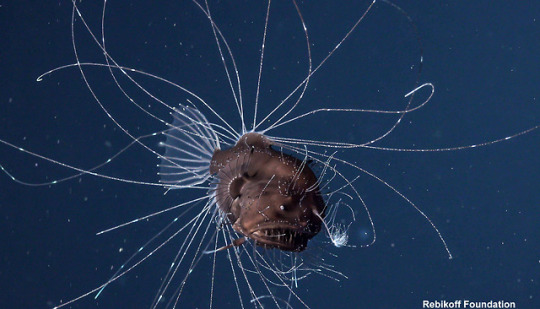
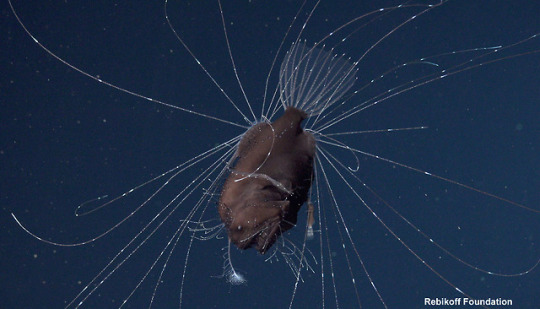
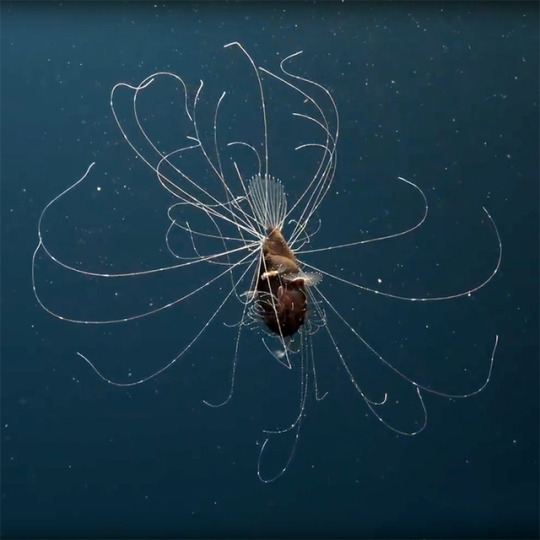
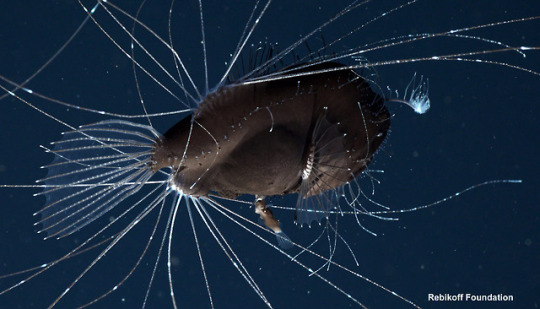
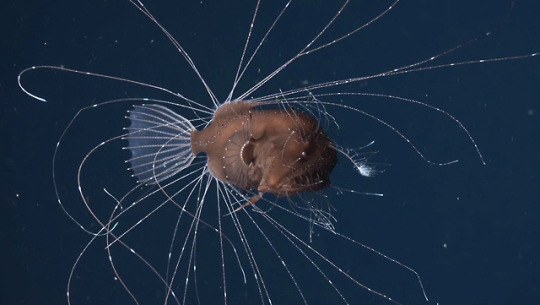

Gorgeous female Fanfin Seadevil (Caulophrynidae) with a tiny parasitic male attached. It is one of the few times this species has been observed alive.
youtube
#Animal#Fish#Anglerfish#Gnathostomata#Eugnathostomata#Teleostomi#Osteichthyes#Actinopterygii#Neopterygii#Teleost#Acanthomorpha#Acanthopterygii#Lophiiformes#Ceratioidei#Caulophrynidae#Fanfin Seadevil#Caulophryne#Caulophryne jordani#Fanfin Angler
3 notes
·
View notes
Photo

A selection of deep-sea anglerfish in the sub-order Ceratioidei. This sub-order currently contains 160 separate species, making it the most diverse vertebrate taxon to exist in the bathypelagic zone and below. Ceratioidei fishes are famous for their bizarre sexual dimorphism, in which the shrimpy little males affix themselves permanently to the flesh of the enormous females, feeding off her blood and providing sperm when needed. Image by Theodore W. Pietsch and Christopher P. Kenaley
26 notes
·
View notes
Text

I posted 38,508 times in 2022
That's 14,823 more posts than 2021!
3,424 posts created (9%)
35,084 posts reblogged (91%)
Blogs I reblogged the most:
@superchat
@mysterious-heroine-x-alter
@rinlanddess
@ceratioidei
@oneechangoddess
I tagged 6,803 of my posts in 2022
#asks - 550 posts
#anon - 438 posts
#yeah - 99 posts
#youtube - 99 posts
#fav - 72 posts
#arknights - 61 posts
#elden ring - 55 posts
#cute fashion - 51 posts
#:3 - 37 posts
#xenoblade chronicles 3 - 29 posts
Longest Tag: 140 characters
#yamu yamu yamu yamu yamu yamu yamu yamu yamu yamu yamu yamu yamu yamu yamu yamu yamu yamu yamu yamu yamu yamu yamu yamu yamu yamu yamu yamu
I sent 1 gift in 2022
My Top Posts in 2022:
#5
who said a white boy cant get squirky on the beat
12,047 notes - Posted September 14, 2022
#4

(source)
12,689 notes - Posted August 26, 2022
#3
right before this weeks episode i saw a noticeably higher uptick in horny kobeni on my twitter, from artists posting thicc kobeni to kobeni cosplayers showing their ass with some caption like "sloppy WHAT devil??"

Kobeni stock reaches all time high before immediately collapsing. millions are left in shambles marking the event as one of the most devastating "is actually a failgirl and not a fetish" moments in history
15,468 notes - Posted November 17, 2022
#2
tumblr_video

SWAD666
23,601 notes - Posted March 20, 2022
My #1 post of 2022
tumblr_video

157,258 notes - Posted August 18, 2022
Get your Tumblr 2022 Year in Review →
#tumblr2022#year in review#my 2022 tumblr year in review#your tumblr year in review#14k more than 2021...yabai..
8 notes
·
View notes
Note
theres nothing that gets me as mad as when im trying to find different deepsea fish and i search it and 99% od things i get are just. Ceratioidei (its those spooky ones with light bulb attached to their head that attracts prey with light i duno how to explain it properly but theyre probably the most well-known deepsea fish)
OK BUT LIKE SAME ceratioidei is the only deep sea fish I knew till I got to the internet and it frickin sucks. I def know a lot of em, I just... forgot how they’re called, ugh
2 notes
·
View notes
Text
Maybe something mythological?

I, too, was once fascinated by the appearance of this creature. I love Ceratioidei. Deep sea anglers look amazing. In our country, this eccentric is called "Sea Devil".
14 notes
·
View notes
Photo

Happy mail day! I ordered a few tees from @society6 this one is of my Albert Gotthilf anglerfish on the mens fitted black triblend tee. I don't think this design gets the love that it deserves. . . . . #anglerfish #deepsea #deepseacreatures #seacreature #seacreatures #marinebiology #sealife #fish #scientificillustration #science #scienceart #benthic #Society6 #tshirtdesign #vintagedrawing #fishlover #fishtagram #fishofinstagram #fishy #aquatic #aquarium #ichthyology #lophiiformes #teleost #illicium #ootd #Ceratioidei #pelagic #bonyfish #shareyoursociety6 — view on Instagram https://ift.tt/3hpmSFq
0 notes
Photo


● Ceratioidei ●
2 notes
·
View notes
Text
Bioluminescence in Fishes: Diversity and Functions- Juniper Publishers
Introduction
Bioluminescence is a amazing biological phenomen, which can be found in terrestrial and oceanic environments. Numerous bioluminescent taxa were described from the marine environment [1-2]. Bioluminescence is especially abundant in the deep-sea. The majority of luminescent taxa are invertebrate animals. In contrast to the high diversity in invertebrates, vertebrates lack bioluminescent light organs, with the exception of an amazing diversity in teleosts and some shark species. A recent paper reported that bioluminescence appeared in ray finned fishes in 27 independent evolutionary events [3]. Bioluminescent light is generated in spezialized light organs based on a oxyidation of a light emitting luciferine in the presence of oxygene and the enzyme luciferin [1,4]. Most of the bioluminescent species produce blue green light in the wavelength range around Xmax ~475nm [1]. Luminescence in fishes can be divided in two different types of light production. Fish species with intrinsic bioluminescence show their own luciferin-luciferase sytem in specialized light organs. Nitric oxide was suggested to modulate adrenaline stimulated light emission in hatchet fishes of the genus Argyropelecus [5].
In case of cartilaginous fishes, luminescence is controlled by the application of melatonin as reported for the pygmy shark Squaliolus aliae [6]. Fish species with extrinsic bioluminescence are not able to control their light emision directly. These species host bioluminescent bacterial species in specialized light organs. The bioluminescent bacteriae produce a constant light and fishes with extrinsic luminescence use mechanical structures to cover the light organs and produce impressive blink patterns during the night. The flashlight fishes (Anomalopidae) for example use different mechanisms to close their light organs [7]. Numerous studies that describe the anatomy, diversity, function and evolution of bioluminescent light organs in fishes were published in the last 100 years. The objective of this review is to give a short overview about the functions of extrinsic and intrinsic luminescence in fishes.
Go to
Fishes With Intrinsic Bioluminescence
Fish species with intrinsic luminescence use their own luciferine-luciferase system to produce light. Many different types of light organs and functions of light organs were described. Bioluminescent sharks use ventral photophores to mimic residual light from the water surface and remain unseen by potential predators. This function is called counter illumination. The sharks produce a constant glow and swim up and down in the water to remain unseen and follow a so called «iso luminance depth» [8]. The small deep- sea lantern-shark Etmopterus spinax was suggested to use a light organ on the dorsal spine as a visual signal that deter predators in addition to the ventral light organs for counter illumination [9]. The tiny cookie-cutter shark Isistius brasiliensiss how a unusual feeding behavior.
The small shark bites small round pieces flesh from pelagic predators like swordfish and tunas. One study suggested that Istius brasiliensis use the ventral photophores to lure pelagic predators instead of the usual function of counterillumination [10]. Lantern fishes (Fam: Myctophidae) show a high diversity and are highly abundant in the mid water column. Lantern fishes have photophores that glow to the sides and downward. In addition lantern fishes show a large photohore that produce strong and short (400ms) light flashes [2,11].
The dragonfishes (Order: Stomiiformes) is a amazing group of bioluminescent fishes. In addition of emitting blue- greenish light, like the most luminescent fish species, dragon fishes produce long wavelength red light. The three dragonfish genera Malacosteus, Pachystomias and Aristostomias show suborbital photophores that emit long wavelength red light and postorbital photophores that glow blue. In addition the genus show a preorbital photophore that produce red light [12]. The function of red bioluminescence might be related to intraspecific communication [12] and it has been suggested that dragonfish Malacosteus Niger use red luminescence to see without seen by other animals [13].
Go to
Fishes With Extrinsic Bioluminescence
Fishes wit extrinsic luminescence lack their own luciferine luciferase system. They host symbiotic bacterial species in specialized light organs that can either be appendages of the alimentary tract or they show light organs under the eyes (Fam.: Anomalopidae), in a specialized dorsal fin ray (Fam.: Ceratioidei) or light organs at the anterior angle of the lower jaw (Fam.: Monocentridae) [1,4,7,14,15]. Less is known about the transport of symbionts from one generation to the next and about the ontogenetic development of luminescence onset in fishes. The cardinalfish (Fam.: Apogonidae) Siphamia tubifer show a ventral light organ and is active during twilight. It has been suggested that Siphamia use the light to detect and find zooplankton [16]. The mouth breeding Siphamiahost the luminescent symbiotic bacterial species Photobacterium mandapamensis and one study described that the symbiosis was initiated 8-10 days after the release of the parents mouth [17]. Many deep-sea anglerfishes (Fam: Ceratoidae) use a luminescent lure at the tip of a modificated dorsal fin ray and host symbiotic bacteriae related to the genus Vibrio. Angler fishes are generally thought to use the lure to attract prey organisms in the darkness of the deep-sea [18-21]. Prey capture was also suggested for Gazza minuta (Fam: Leiognathidae) display a discrete projected luminescence and it was proposed that Gazza minuta attract and locate the fish on which Gazza minuta nocturnally feeds. The flashlight fishes (Fam: Anomalopidae) comprises 6 genera including 9 valid species [22-29]. Anomalopskatoptron, Photoblepharon palpebratum and Photoblepharon steinitzi live in relatively shallow waters of coral reefs and feed on zooplankton during the night. Flashlight fishes show enhanced activity during the night. They show bean-shaped light organs under the eyes and host bacteria of the genera Candidatus Photodesmus in Anomalops katoptron [30] and Candidatus Photodesmus blepharus in Photoblepharon [31] . Interestingly the related species Anomalops katoptron and Photoblepharon palpebrum/steinitzi use different mechanisms to close their light organs. Anomalopsrotate the light organ down and backwards whereas Photoblepharon use an eylid like shutter [7]. Several functions of light organs and blink patterns in flashlight fishes have been proposed [32,33].
The light organs assist in predation, i.e. to see or attract prey organisms.
To avoid predators, i.e. evasive swimming behavior coordinated with rapid blinking (blink-and-run pattern).
Intraspecific communication, i.e. school formation, territorial behavior and courtship behavior. Photoblepharon live in pairs or small groups between corals and rocks [34,35].
In contrast, A. katoptron swim in schools of up to 200 specimens near the water surface [34,35]. Several functions of bilominescence like communication, feeding behaviour and territorial behaviour were suggested for Photoblepharon steinitzi[32] . The split finflash light fish Anomalops katoptron us their light organs to illuminate small zooplankton organisms during the night. They display a high frequent blink pattern during the night and switched to constant glowing in the presence of planktonic prey organisms. The blink pattern of the light organs also follow an exogenous control by the ambient light, I.e. during dim light conditions the light organ is mainly closed [14]. Bioluminescence in fishes is highy diverse and needs further laboratory and field studys to investigate the exact functions of luminescence in fishes especially in deep-sea and coral reef ecosystems.
Go to
Summary
Bioluminescence in fishes is a widespread phenomenon in oceanic environments. Bioluminescenc can be found in ray finned fishes and also in some small shark species. Fishes can either display intrinsic bioluminescence, i.e the have their own luciferin-luciferase system or extrinsic luminescence, i.e. they host symbiotic luminescent bacteriae in specialized light organs. Bioluminescence in fishes has diverse functions and it is used for illuminating prey organisms, attracting prey, communication, counter illumination and territorial behaviour.
To Know More About Journal of Oceanography Please Click on: https://juniperpublishers.com/ofoaj/index.php
To Know More About Open Access Journals Publishers Please Click on: Juniper Publishers
0 notes
Photo

The triplewart sea devil (Cryptopsaras couesi), a species of anglerfish, uses a modified portion of its dorsal fin like a fishing pole to lure would-be prey toward its mouth. Only females are equipped with this bioluminescent, prey-baiting adaptation. The much smaller males, in contrast, are parasitic mates, holding on to females with a mouthful of spiny teeth. The tissues and circulatory systems of both fish eventually fuse together until the male has lost all internal organ function except sperm production.
Photo: Solvin Zankl
#Animal#Fish#Anglerfish#Lophiiformes#Chordata#Vertebrate#Gnathostomata#Eugnathostomata#Teleostomi#Osteichthyes#Actinopterygii#Neopterygii#Teleost#Acanthomorpha#Acanthopterygii#Ceratioidei#Ceratiidae#Warty Sea Devil#Cryptopsaras#Cryptopsaras couesii#Triplewart Sea Devil
0 notes